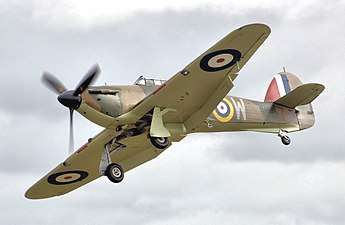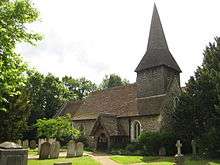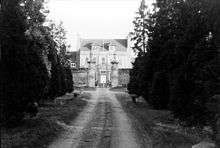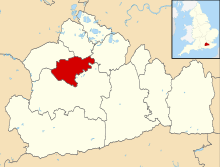Byfleet
| Byfleet | |
|---|---|
 Byfleet Village Hall | |
 Byfleet Byfleet shown within Surrey | |
| Area | 6.24 km2 (2.41 sq mi) |
| Population | 7,724 (ward, 2011)[1] |
| • Density | 1,238/km2 (3,210/sq mi) |
| OS grid reference | TQ078648 |
| District | |
| Shire county | |
| Region | |
| Country | England |
| Sovereign state | United Kingdom |
| Post town | West Byfleet |
| Postcode district | KT14 |
| Dialling code | 01932 |
| Police | Surrey |
| Fire | Surrey |
| Ambulance | South East Coast |
| EU Parliament | South East England |
| UK Parliament | |
Byfleet is a village in Surrey, England. It is located in the far east of the borough of Woking, around 1.5 miles (2.4 km) east of West Byfleet, from which it is separated by the M25 motorway and the Wey Navigation.
The village is of medieval origin. Its winding main street, High Road, contains old large public houses, a church and several timber-framed houses, as well as other 16th and 17th century houses with listed status. The former Brooklands motor racing circuit is located just to the north, while to the east, across the River Wey, is the former Silvermere estate, now a golf club.
Byfleet is served by Byfleet & New Haw railway station, on the South Western main line.
July 2012 marked a significant moment in Byfleet's history, as it became a host of the men's and women's cycling road races for the 2012 Summer Olympics.
History


The village was in the Godley hundred, a Saxon division for strategic and taxation purposes. Byfleet appears in Domesday Book as Byeflete. It was held by Ulwin (Wulfwin) from Chertsey Abbey. Its domesday assets were: 2½ cultivated hides; 1 church, 1 mill rendering 5 shillings per year, 1½ fisheries worth 325 eels (per year), 6 acres (2.4 ha) of meadow, woodland worth 10 hogs. It was taxed to render all in all £4 for the year to its overlords.[2]
Industrial history
Byfleet expanded considerably after the opening of the Brooklands motor circuit in 1907 and when major aircraft factories opened there during World War I. A large housing estate for Vickers aircraft workers was built between Chertsey Road and Oyster Lane in World War I and although sold off by the early sixties, these houses still exist today. The Tarrant Tabor bomber, the largest aeroplane built in Britain during World War I, was constructed in Byfleet by W G Tarrant Ltd but crashed fatally at Farnborough on 26 May 1919 on its first attempted take-off. Several other aeroplanes were built in Byfleet by Glenny & Henderson Ltd in the late 1920s.
The influence of the aircraft industry on the village's development continued between the wars and during World War Two and most of the new aeroplanes built at Brooklands took off over the centre of Byfleet on their first flights – the most spectacular being the first flight of the pioneering Vickers VC10 in 1962. The urgent need to supply the Vickers Valiant V-bomber to the RAF led to the removal of the central section of the race track's Byfleet Banking when a new hard runway was built in 1951.
Various aircraft crashed in and around Byfleet during the first half of the last century; these include a Vickers Viking amphibian (on 13/4/22, flown by record-breaking England-Australia Vickers Vimy pilot Sir Ross Macpherson Smith and Lt Bennett – both men died when they crashed behind the Byfleet Banking just after take-off), the prototype Vickers Wibault (in June 1926, flown by chief test pilot 'Tiny' Scholefield – he baled out and the aeroplane crashed on the Vickers Sports Ground), an RAF Taylorcraft Auster (on 12/3/43, flown by Capt W Whitson who hit a barrage balloon cable on bad visibility and crashed) and an RAF North American P-51 Mustang III (on 6/4/44, flown by S/Ldr Szawblowsky who struck a balloon cable and crashed near Oyster Lane). On 2 January 1945 a Vickers Warwick GRV, s/n PN773, flown by test pilot Bob Handasyde crashed beside Rectory Lane in Three Acre Field close to St Mary's Church and just missed road-sweeper Jack Smith with a wing-tip. Another Vickers employee named Bob Rampling (who lived in nearby Hopfield Avenue) was also on board and was reputedly sent on another test flight that same day.
World War II
Great effects also took place in this part of the county: evacuees, British and Canadian soldiers and German prisoners of war were all accommodated locally and the Vickers factory on the east side of Brooklands was bombed with heavy loss of life on 4 September 1940. By 2200hrs the following day, 21 barrage balloons with rope lines and other military defences were deployed locally including along the nearby Seven Hills Road. The Hawker aircraft factory on the Byfleet side of the aerodrome was targeted two days later resulting in major damage to certain buildings but with no loss of life nor any serious disruption to Hurricane production. The importance of Brooklands to the war effort was emphasised by the construction circa 1941 of a large anti-aircraft gun tower just east of the village at Manor Farm, together with two similar structures built on the north side of Brooklands. Gun crews on each of these 'flak' towers manned a 40mm Bofors gun against further enemy air attacks.
A fatal accident in the centre of Byfleet on 24 September 1942 saw a military Bren Gun Carrier operated by the Welsh Guards collide with the corner of The Plough pub killing a regular lady customer named Miss Edith Minnie Wyatt. She visited the pub regularly around midday and was co-owner of 'The Old Log Cabin' (a small shop opposite nearby Binfield Road) but sadly she died outside the premises having been pinned against the pub's bay window. This part of the building was then shored up with timber for a considerable period of time afterwards.
In 1944 many troops stationed locally departed for France on D-Day and older residents still recall a column of Canadian tanks and other military vehicles which passed through the village at that time with a long tail-back running for two days along High Road between the War Memorial and The Clockhouse. Byfleet also came under attack from V-1 'Doodlebug' flying bombs – two fell beside Byfleet Road on 21 August and slightly injured two people. That same year a new Vickers flight test airfield opened just South of Byfleet at Wisley.
Motor racing and supply
Brooklands' record-breaking racing driver J G Parry-Thomas and Bert Denly, motorcycle racer, lived in Byfleet in the 1920s and the renowned race-tuner Robin Jackson lived at St George's Hill and had an engineering works in Byfleet after World War II. Also post-war, Brooklands' engineer Francis Beart had a small workshop in High Road and specialised in tuning Norton motorcycles.
After World War 2, the village became a greater centre for automotive-related businesses, garages, showrooms and workshops and these included post-war racing driver Duncan Hamilton's racing workshop and car showroom in the west end of High Road, the base for his successful C-type Jaguar victory at Le Mans in 1953. The modern 'Cobb House' in Oyster Lane is presumed to have been named in memory of record-breaking racing driver John Cobb who lived in Esher and the modern 'Birkin Court' in Chertsey Road is assumed to commemorate another racing driver, Tim Birkin.
Sporting venues
During July 2012 Byfleet became a host of the London 2012 Olympic Games when the men's, and ladies, road race passed through the village. The races took place on 28th (men's), and 29th (ladies), of July 2012. The route passed west along the A245, Parvis Road, from Weybridge towards West Byfleet. The route was lined with London 2012 Olympic banners, making the event a real spectacle as it passed through.
Landmarks
Architectural history
Seven buildings are listed, its watermill and two of the churchyard tombs. St Mary's Church in the village centre dates back to at least the 14th century, and medieval elements are kept in the structure of Byfleet Manor, built in 1686 – these are listed at Grade I and Grade II* (the top two categories) respectively.[3]
In 1895, 20-year-old Hampshire-born Walter George Tarrant started a new carpentry business, W G Tarrant Ltd, in Byfleet and later expanded into housebuilding. The company built extensively in Pyrford and West Byfleet in the early 1900s.
In 1898, the village gained an impressive village hall and club, funded by Frederick C Stoop who lived at West Hall between Byfleet and West Byfleet.
By 1911 the Tarrant Works covered c. 5 acres (2.0 ha) and included workshops for joinery, wrought iron and leaded lights, a stonemason's yard and a timber mill with drying sheds. The firm owned nurseries and brickfields elsewhere and was Byfleet's largest employer for many years.
St. Mary's Church
St Mary's Church interior features some very rare wooden crosses (grave markers) recovered from Europe shortly after World War I.
Graves in the churchyard include those of:
- Brooklands-based racing driver J G Parry-Thomas (see above) who died aged 42 at Pendine Sands in 1927 while attacking the world Land Speed Record.
- Record-breaking motorcyclist Bert le Vack who was killed at the age of 44 while testing a new motorcycle in the Swiss Alps in 1931.
- Gerald Napier, the first pilot to be killed in a flying accident at Brooklands, died aged 19 on 1 August 1911.
- Scottish aviation pioneer and Vickers' first test pilot Harold Barnwell who was killed flying a new prototype fighter at Joyce Green Aerodrome near Dartford, Kent, in 1917
- Ebeneezer Mears, construction business founder.
- Honor Wellby, believed to be the first British woman pilot to die flying an aeroplane, who lived with her parents at nearby St George's Hill, crash-landed an Avro 504 on take-off from Brooklands in 1928.
- Victims of the Luftwaffe's 1940 bombing of Brooklands including: 17-year-old Irene Coleman, 36-year-old Edward Eastwood and 21-year-old Gwendoline Goddard, who all worked for Vickers.
- Lt Arthur Doricourt Roberts, MC, RFC, who was killed in a flying training accident near Hanworth on 31 August 1917, aged 22.
Sanway
The history of the Sanway area of Byfleet is largely unrecorded and therefore currently being researched by local historians. Among its original residents in the early 20th century was record-breaking racing motorcyclist Bert Denly who lived in Richmond Cottages.
The Sanway Laundry was a major local employer from the early 1900s until the 1960s with its distinctive green and white delivery vans. One of several late 19th century laundries established in the Sanway area of the village, it moved during World War 1 to occupy part of the former Byfleet Brewery in High Road until closed and redeveloped c.1970 as 'The Willows' housing estate. Another smaller laundry in Binfield Cottages (beside Top Field, Sanway) provided a laundry service for Byfleet Manor and was managed by Mrs Amelia Bailey (later Harling) but closed soon after she died c.1936.
Housing developments
Despite many new housing developments in recent decades and a number of flats for older residents such as 'Barnes Wallis Court' opened in 2009 at the junction of Oyster Lane and Parvis Road, Byfleet Village still has character and a number of interesting old buildings today including 12 nationally designated Listed buildings. Nine others are Locally Listed and the West end of High Road is also a Conservation Area.
21st century
Byfleet is an ancient parish. It was included as a civil parish in the Chertsey Rural District in 1884; it was added to the Woking urban district in 1933 under a County Review Order, thus extinguishing its parish council. The most recent parish council was formed in 1989.[4][5] In June 2005, the Office of the Deputy Prime Minister refused to abolish the parish, despite its own request.[6] In May 2007, a group standing under an "Abolish Byfleet Parish Council" banner won election to the Parish Council and again proceeded to seek its abolition.[7] The civil parish was abolished on 1 April 2010.[8]
The War Memorial commemorates military personnel and civilians who died in both world wars who came from the local community. In the lead up to Remembrance Sunday the memorial is lit up each night. The memorial includes, public benches, flower beds and a beautifully simple, yet empowering stone wall naming each hero that gave their life for justice and freedom.
Lloyds TSB is now the only bank in Byfleet, which has three pubs (as The King's Head in local-traffic only Chertsey Road was demolished 2011), a post office, co-op, Budgens and a large variety of other local shops and businesses.
A village market is held on the green on the first Saturday every month except January, and the traditional Byfleet Parish Day is held on the recreation ground with supporting events in the nearby village hall and St Mary's Day Centre every July.
The nationally listed 'Clockhouse' in High Road in the east is an 18th-century mansion extended and converted in the 1960s into a retirement communal home for the elderly before its latest renovation as flats for the over-fifties was completed in 2009.
The Blue Anchor Hotel was on 29 March 1924 the setting for a notorious murder. In January that year 41-year-old Mabel Theresa Jones, wife of landlord Alfred George Poynter Jones, had travelled to Biarritz to recover from a nervous breakdown. At Biarritz's Hôtel Victoria, with the aid of a French-English dictionary, she was seduced by 45-year-old French wireless operator Jean-Pierre Vaquier. When Mabel received a telegram from her husband calling her back to Byfleet, Vaquier followed, and in London the affair continued. Vaquier then took a room at the Blue Anchor and eventually killed Alfred Jones by adding strychnine to the dose of salts Jones habitually took as a hangover cure. Vaquier was hanged at Wandsworth Prison on 12 August 1924.
Parvis Road was part of the 2012 Olympics Cycle Road Race route in July 2012 and also for the practice race for 150 entrants on 14 August 2011, which was won by British team member Mark Cavendish.
In the centre of Brooklands in September 2012, Brooklands Museum installed the 40% scale model of the iconic Concorde airliner previously displayed near the entrance to London Heathrow Airport's Central Terminal Tunnel. Repainted in authentic 1970s airline colours, the model now sits proudly beside the junction of Wellington Way and Sopwith Drive as an impressive symbol of Brooklands' aviation and industrial heritage.
The latest retail outlet in Byfleet is the Home Bargains store which opened on 13 December 2014.
Byfleet Heritage Society
The Byfleet Heritage Society formed in 1996 and has detailed historical displays in Byfleet Library's Heritage Room with popular monthly meetings in the former Victorian school, now the St Mary's Centre. Recent Society projects include researching such subjects as Byfleet's numerous shops and businesses, village life in both world wars, the Stoop family and West Hall and, thanks to the support of Surrey County Council and many volunteers, finding and recording the gravestones and memorials for over 2,500 known burial locations in St Mary's Churchyard – resulting in a new interactive map and database launched and added to the Society's website on 29 March 2015. A blue plaque organised by the Society in memory of the well known early 20th century Dutch benefactors, Frederick and Agnes Stoop (who lived in nearby West Hall), was officially unveiled on front of the Village Hall by the Dutch Cultural Attache, Daphne Thissen, on 11 September 2015.
Byfleet Fire Station
This rare surviving example of a Victorian village fire station was built at the West end of High Road in 1885 by notable local MP and former Lord Mayor of London Sir John Ellis and served the village until closed in 1963. Owned by Surrey County Council, it was designated a Grade 2 Listed building in 2008 and thanks to a partnership of Brooklands Museum, the Byfleet Heritage Society and other local organisations, this historic building is now under gradual restoration for a heritage-related community use. Since 2008, volunteers have researched its history, secured grants and sponsorship, organised professional conservation and condition surveys, prioritised and carried out essential repairs, staged regular public open days and improved the building's internal and external appearance. In November 2009 a new development of retirement flats (appropriately named Ellis Court) was completed beside the fire station. Roof repairs were made in 2012 and, with the aid of two further grants, the electrics were totally renewed in 2013 and all exterior doors were repaired and repainted in 2014.
Immediate surroundings
Byfleet borders on two sides the Brooklands retail park (including Tesco, Argos, Mothercare and Marks & Spencer) on part of the former Brooklands motor circuit and aerodrome (now dominated by Mercedes-Benz World and the Brooklands Hotel) – see Weybridge. St George's Hill, Weybridge adjoins to the north-east. Cobham is East and to the east of West Byfleet. A stopping-service station on the South West Main Line connects the village to Central London, Byfleet and New Haw railway station, on the northern border of the industrial/commercial Brooklands Trading Estate.
Demography
The proportion of households in Byfleet who owned their home outright was just over 9% greater than the borough and regional average. The proportion who owned their home with a loan was 4% greater than the regional average; providing overall a lower proportion than average of rented residential property and of social housing, and close to the average in Surrey.[1]
| Output area | Population | Households | % Owned outright | % Owned with a loan | hectares[1] |
|---|---|---|---|---|---|
| Byfleet (ward) | 7,724 | 3,174 | 32.4 | 44.3[1] | 624[1] |
Local government
At Surrey County Council, one of the 81 representatives represents the area for The Byfleets division.[9]
At Woking Borough Council. a few wards of the borough are deemed appropriate to be represented under the current constitution of councillors by three councillors, which is the case for Byfleet.[10]
| Election | Member[10] |
Ward | |
|---|---|---|---|
| 2016[11] | John Bond | Byfleet | |
| 2016[11] | Amanda Boote | Byfleet | |
| 2016[11] | Mary Bridgemane | Byfleet | |
| Election | Member[12] |
Electoral Division | |
|---|---|---|---|
| 2013 | Richard Wilson | The Byfleets | |
Literature
Byfleet is mentioned in chapter 12 of The War of the Worlds by H. G. Wells;
Byfleet was in a tumult; people packing, and a score of hussars, some of them dismounted, some on horseback, were hunting them about. Three or four black government waggons, with crosses in white circles, and an old omnibus, among other vehicles, were being loaded in the village street. There were scores of people, most of them sufficiently sabbatical to have assumed their best clothes. The soldiers were having the greatest difficulty in making them realise the gravity of their position. We saw one shrivelled old fellow with a huge box and a score or more of flower pots containing orchids, angrily expostulating with the corporal who would leave them behind.
Notable alumni
- Sir George Barnes – born in Byfleet in 1904; Controller of BBC Radio and Television in the 1940s and 50s. Principal of the University College of North Staffordshire, now Keele University 1956–60.
- Harry Dodson – born in Byfleet; presenter of 1987 TV series The Victorian Kitchen Garden.
- Sir John Ellis – former Lord Mayor of London, MP and founder of Byfleet Fire Brigade, lived at Petersham House in High Road in the late 19th century.
- Sarah Miles – lived in Byfleet in the late 1960s – early 1970s.
- John Godfrey Parry-Thomas – engineer and record-breaking racing driver, lived in The Hermitage inside the Brooklands Track, killed on Pendine Sands and buried in St Mary's Churchyard in 1927.
- Joseph Spence – 18th Century historian.
- Walter George Tarrant – lived at Lake House, Chertsey Road.
See also
References
- 1 2 3 4 5 Household size, population and tenure key statistics United Kingdom Census 2011, Office for National Statistics. Retrieved 31 October 2014
- ↑ Surrey Domesday Book Archived 15 July 2007 at the Wayback Machine.
- ↑ Historic England. "Details from listed building database (1378241)". National Heritage List for England. Retrieved 31 October 2014.
Historic England. "Details from listed building database (1236613)". National Heritage List for England. Retrieved 31 October 2014. - ↑ "The Woking (Parish of Byfleet) Order 1989" (PDF). Lgbce. Retrieved 15 March 2018.
- ↑ Woking Borough Council
- ↑ Woking Lib Dems
- ↑ Woking News
- ↑ "Bulletin of changes to local authority arrangements, areas and names in England" (PDF). Lgbce. Retrieved 15 March 2018.
- ↑ Electoral Divisions Archived 2 December 2013 at the Wayback Machine. Surrey County Council. Retrieved 6 November 2013
- 1 2 Your local councillors Woking Borough Council. Retrieved 6 November 2013
- 1 2 3 Four-yearly election results, 2016 Woking Borough Council. Retrieved 25 October 2016
- ↑ Your Councillor Surrey County Council. Retrieved 6 November 2013
Bibliography
- Flower, Stephen (1994) 'Raiders Overhead – The Bombing of Walton & Weybridge' (Air Research Publications, Walton on Thames)
- Gardner, Charles (1956) 'Fifty Years of Brooklands' (Heinemann).
- Gilbert, James (1975) 'The World's Worst Aircraft – A Rogue's Gallery of Flying Follies' (M & J Hobbs Ltd & Michael Joseph Ltd) – see chapter on the Byfleet-built Tarrant Tabor bomber.
- Norris, Richard (2008) 'The Life and Works of Walter George Tarrant' (self-published).
- Stevens, Leonard R (1977, Reprinted and Revised edition) The Parish Church of St Mary The Virgin Byfleet' (printed locally).
- Stevens, Leonard, E, (2nd edition reprint, 2001) 'Byfleet – A Village of England'(Byfleet Heritage Society).
- Wakeford, Iain (2000) 'Byfleet – A Heritage Walks Guide' (AK, HR & DA Wakeford, Old Woking, Surrey).
External links
| Wikimedia Commons has media related to Byfleet. |
- Byfleet News and Mail
- Byfleet's Community & Social Networking Website
- Byfleet Heritage Society website
- Surrey County Council. "Byfleet". Exploring Surrey's Past. Retrieved 30 May 2017.

